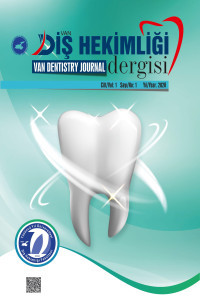İmplant Stabilitesi Değerlendirmesinde Model Materyali Olarak Kalsiyum Fosfat Kullanılabilir mi?
Kalsiyum fosfat, dental implant, kemik modeli
Can Calcium Phosphate Be Used as a Model Material for Implant Stability Evaluation?
Calcium phosphate, dental implant, bone modal,
___
- 1. Singh K, Rao J, Afsheen T, Tiwari B. Survival rate of dental implant placement by conventional or flapless surgery in controlled type 2 diabetes mellitus patients: A systematic review. Indian J Dent Res. 2019;30(4):600- 611.
- 2. Jivraj S, Chee W. Rationale for dental implants. Br Dent J. 2006;200(12):661-665.
- 3. Setzer FC, Kim S. Comparison of Long-term Survival of Implants and Endodontically Treated Teeth. Journal of Dental Research. 2014;93(1):1926.
- 4. Salvi, G. E.,Monje, A., &Tomasi, C. Longterm biological compli- cations of dental implants placed either inpristineor in augmentedsites: A systematic review and metaanalysis. Clin Oral Implants Res.2018;29(Suppl 16):294–310.
- 5. Eriksson R, Albrektsson T: Temperature thres holds for heat- induced bone tissue injury: A vital-microscopic study in the rabbit. J Prosthet Dent. 1983;50:101.
- 6. Ercoli C, Funkenbusch PD, Lee H-J, Moss ME, Graser GN. The influence of drill wear on cutting efficiency and heat production during osteotomy preparation for dental implants: a study of drill dura- bility. Int J Oral Maxillofac Implants.2004;19:335–349.
- 7.Sharawy M, Misch CE, Weller N, Tehemar S. Heat generation during implant drilling: The significance of motor speed. J Oral Maxillofac Surg 2002;60:1160‐1169.
- 8(12). Watanbe F, Tawada Y, Komatsu S, Hata Y. Heatdistri- bution in bone during preparation of implantsites: heat analysis by real-time thermography. Int J Oral Maxillofac Implants.1992;7:212–219
- 9. Möhlhenrich SC, Modabber A, Steiner T, Mitchell DA, Hölzle F. Heat generation and drill wear during dental implant site preparation: systematic review. Br J Oral Maxillofac Surg. 2015;53(8): 679–689.
- 10. Reingewirtz Y, Szmukler-Moncler S, Senger B: Influence of different parameters on bone heating and drilling in implantology. Clin Oral Implant Res. 1997;8:189.
- 11. Yeniyol S, Jimbo R, Marin C, Tovar N, Janal MN, Coelho PG. The effect of drilling speed on early bone healing to oral implants. Oral Surg Oral Med Oral Pathol Oral Radiol. 2013;116:550-555.
- 12. Iyer S, Weiss C, Mehta A. Effects of drill speed on heat production and the rate and quality of bone formation in dental implant osteotomies, part I: relationship between drill speed and heat production. Int J Prosthodont. 1997;10:411-414.
- 13.Gaspar J, Borrecho G, Oliveira P, Salvado F, Martinsdos Santos J. Osteotomy at low-speed drilling without irrigation versus high-speed drilling with irrigation: an experimental study. Acta Med Port. 2013;26:231-6.
- 14.Möhlhenrich SC, Kniha K, Heussen N, Hölzle F, Modabber A. Effects on primary stability of three different techniques for implant site preparation in synthetic bone models of different densities. Br J Oral Maxillofac Surg. 2016;54(9):980-986.
- 15. Pesqueira AA, Goiato MC, Filho HG, et al. Use of stres analysis methods to evaluate the biomechanics of oral rehabilitation with implants. J Oral Implantol. 2014;40(2):217- 228.
- 16. Khasnis N, Dhatrak P, Kurup A. Materials Today: Proceedings. 2021;39:114–120.
- 17. Palissery V, Taylor M, Browne M. Fatigue Characterization of a Polymerfoamtouse as a cancellous bone analog material in the assessment of orthopaedic devices. J. Mater. Sci. Mater. Med. 2004;15:61-67.
- 18. Bicudo P, Reis J, Deus AM, Reis L, Vaz MF. Performance evaluation of dental implants: An experimental and numerical simulation study. Theor. Appl. Fract. Mech. 2016;85:74-83.
- 19. Fu Q, Rahaman MN, Bal BS, Brown RF, Day DE. Mechanicaland in vitro performance of 13–93 bioactive glasss caffolds prepared by a polymerfoamreplication technique. Acta Biomater. 2008:4;1854-1864.
- 20. Tcacencu I, Rodrigues N, Alharbi N, Benning M, Toumpaniari S, Mancuso E, Marshall M, Bretcanu O, Birch M, McCaskie A, Dalgarno K. Osseointegration of porous apatitewollastonite and poly (lacticacid) composite structures createdusing 3D printing techniques Mater. Sci. Eng., C. 2018;90:1-7.
- 21. Nanci A. Ten Cate's Oral Histology: Development, Structure, and Function. 8th edition, St. Louis: Elsevier, 2013.
- 22. Karageorgiou V and Kaplan D. Porosity of 3D biomaterial scaffold sand osteogenesis. Biomaterials. 2005;26.5474-5491.
- 23. Cooper DM, Matyas JR, Katzenberg MA and Hallgrimsson B. Comparison of micro computed tomographic and microradiographic measurements of cortical bone porosity. Calcif. TissueInt. 2004;74:437-447.
- 24. Chen QZ, Boccaccini AR, Zhang HB, Wang DZ and Edirisinghe MJ. Improved mechanical reliability of bone tissue engineering ( Zirconia) scaffolds by electrospraying. J. Am. Ceram. Soc. 2006;89:1534-1539.
- 25. Boccaccini A, Ma PX. Tissue Engineering Using Ceramics and Polymers. Second edition, Amsterdam: Elsevier, 2014.
- 26. Almela T, Brook I, Khoshroo K, Rasoulianboroujeni M, Fahimipour F, Tahriri M, Dashtimoghadam E, El-Awa A, Tayebi L, Moharamzadeh K. Simulation of corticocancellous bone structureby 3D printing of bilayer calcium phosphate-based scaffolds. Bioprinting. 2017;6:1-7.
- Başlangıç: 2020
- Yayıncı: Van Yüzüncü Yıl Üniversitesi
Hasan HASHASH, Hülya ERTEN CAN, Meryem POLAT GÖNÜLLÜ, Ahmet GÜRAL, Hanife ALTINIŞIK
İmplant Stabilitesi Değerlendirmesinde Model Materyali Olarak Kalsiyum Fosfat Kullanılabilir mi?
Levent CİĞERİM, Zeynep Dilan ORHAN, Nazlı Hilal KAHRAMAN, Mohammad ALSMADI, Mohammad BSAILEH
Diş Eti Çekilmesi Tedavisinde Tünel Tekniği ile Birlikte Çift Çapraz Sütur Uygulaması: Olgu Serisi
Nazlı Hilal KAHRAMAN, H. M. Youssef ELBAHİSİ, Serap KESKİN TUNÇ, Hüseyin GÜDÜCÜOĞLU
Zeynep Dilan ORHAN, Nazlı Hilal KAHRAMAN, Levent CİĞERİM, Mohammad ALSMADI
